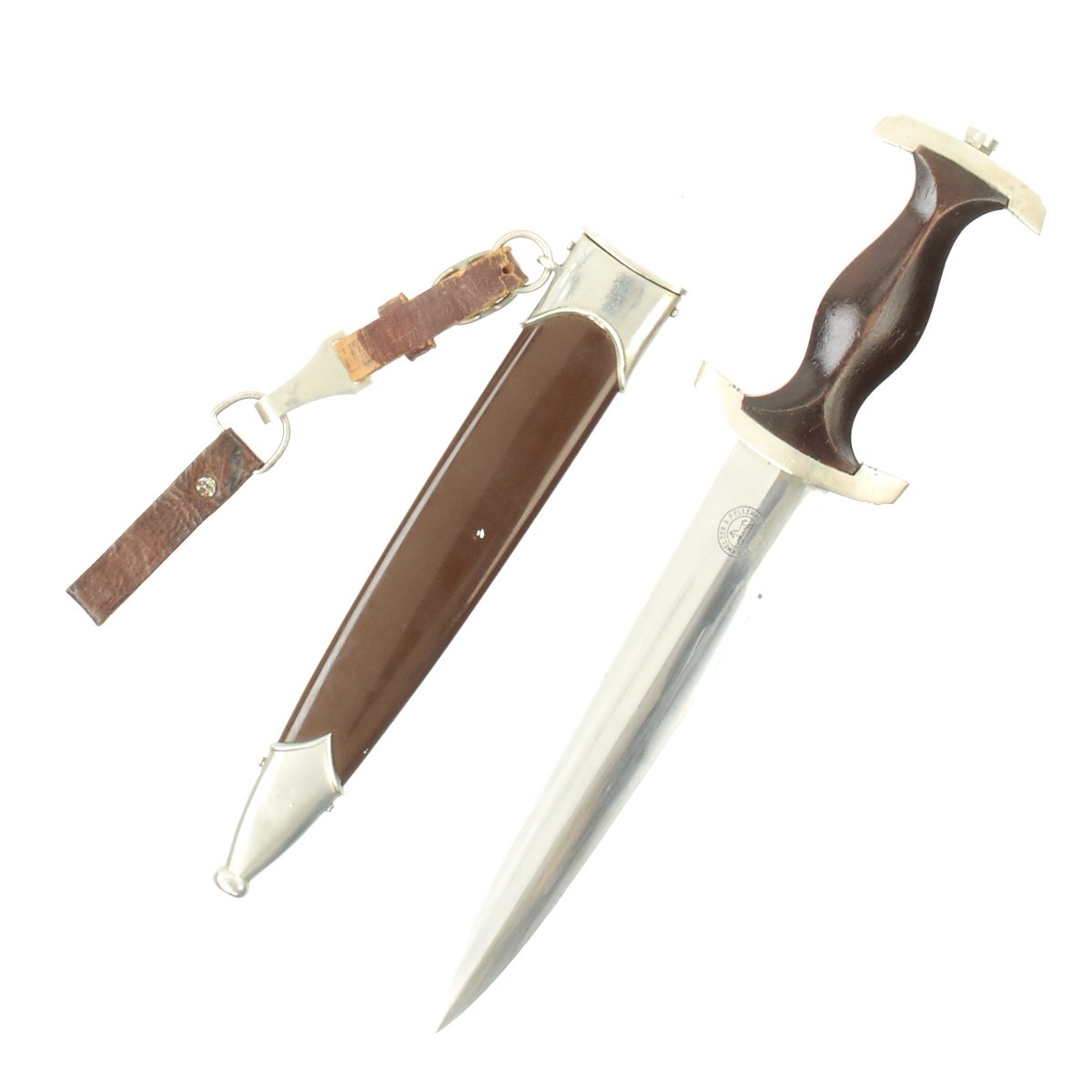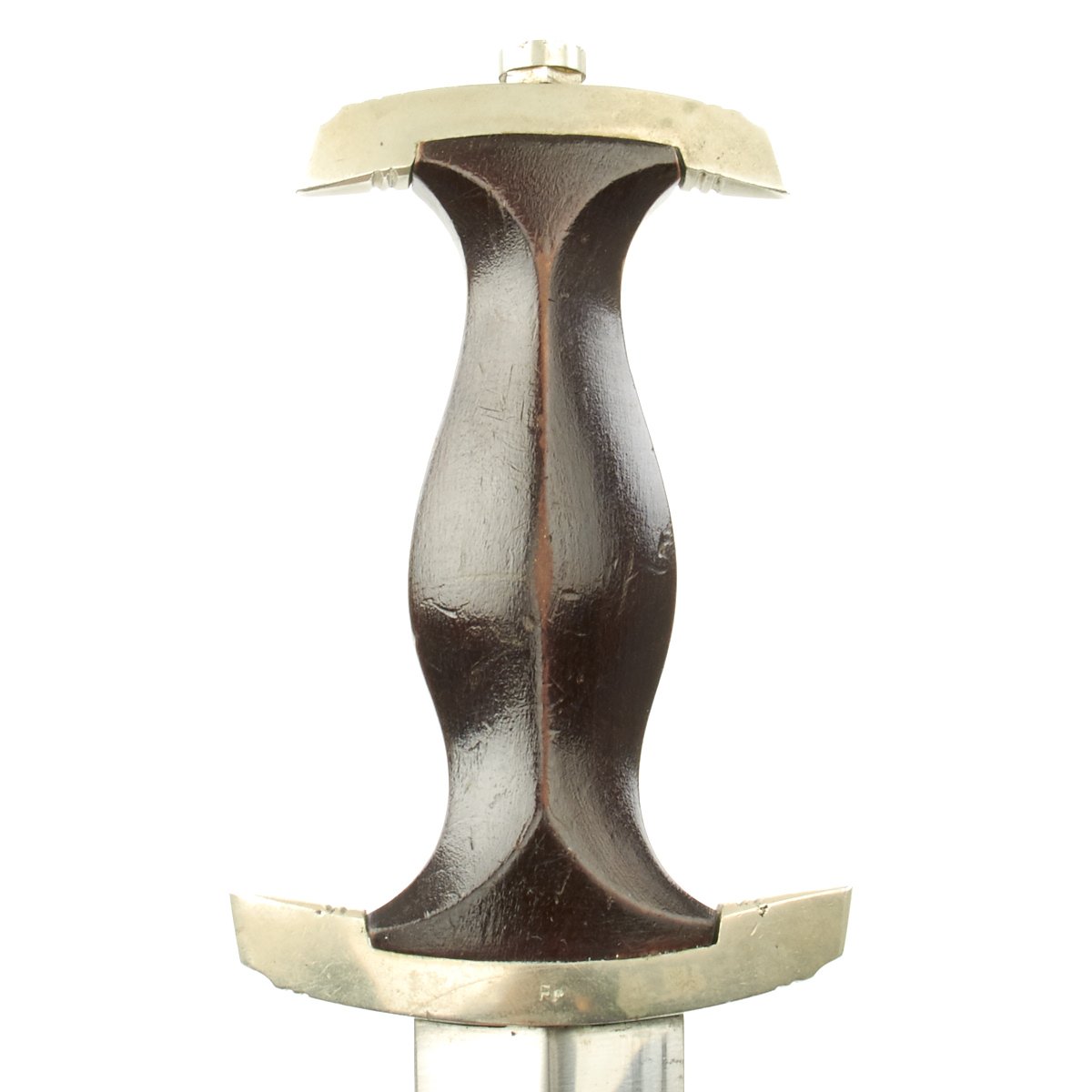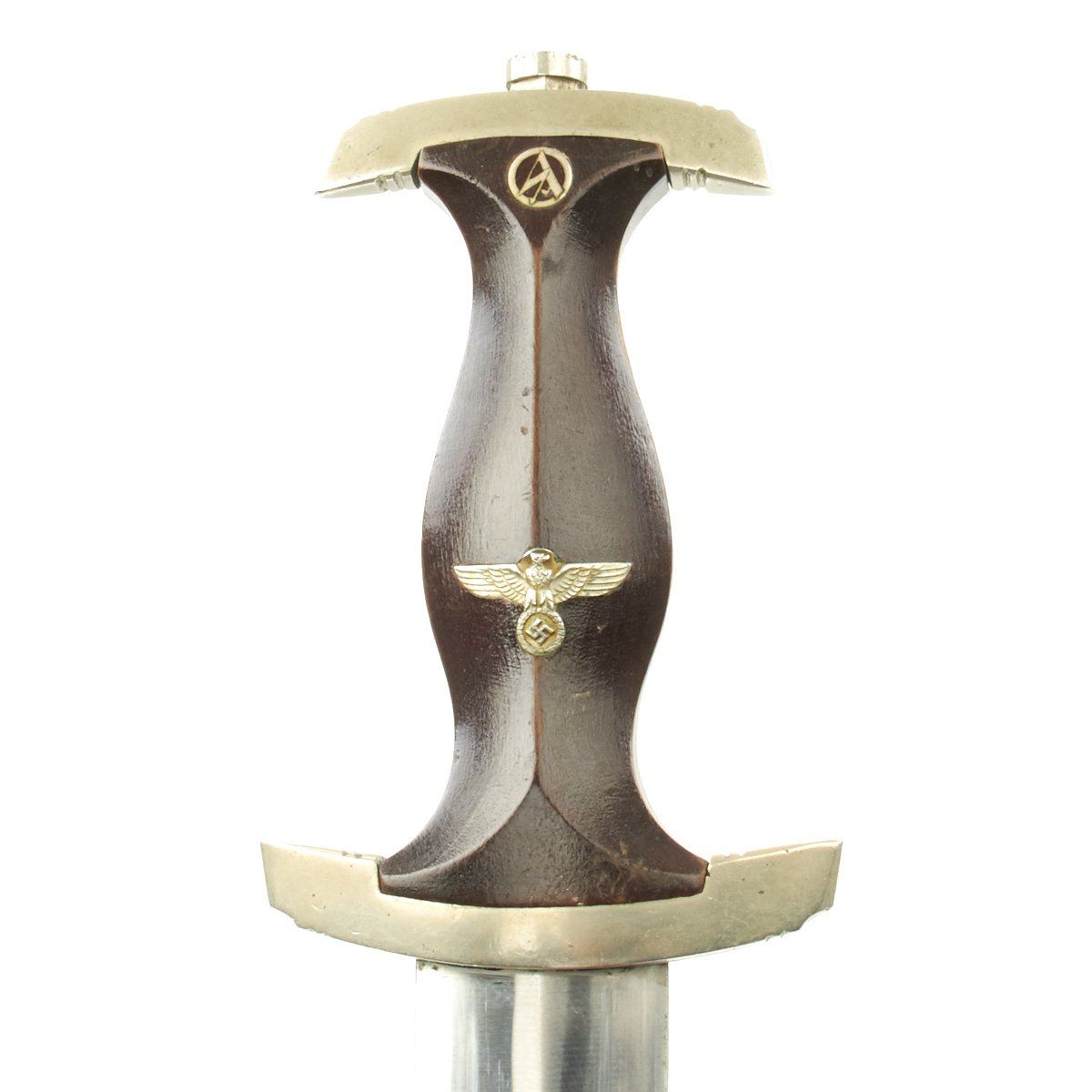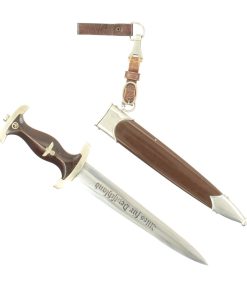Original German Early WWII SA Dagger by Melzer & Feller of Zella-Mehlis with Hanger and Belt Loop Original Items
$ 895,00 $ 223,75
Original Item: Only One Available. This is a very nice early pattern SA Dagger, made by firm of Melzer & Feller in Zella-Mehlis, near Suhl, Germany. It comes comes compete with the original scabbard, as well as a leather belt hanger clip and loop. The dagger has solid nickel silver fittings throughout, and is really a quite nice example. The crossguards and tang nut are in very good condition throughout with all fittings having a nice aged patina. There is a little age to these mounts but there is no lifting anywhere. There are some light scratches and cuts, showing that the fittings are in fact solid nickel silver.
The lower reverse guard is Gruppe/Gau marked Fr, for Franken, which encompassed the area near Nuremberg and Suhl, the correct region for this maker.
The grip is a fine product having a nice chestnut color finish and having medium center ridge construction. This grip is in very good condition and fits the crossguards very closely. The symbol button is nicely set, and still has all of the enamel intact. The grip eagle is a fine example being the style with beak that points straight. The details are still there to the eagle to include the beak, breast feathering, wing feathering, talons, wreath and mobile swas. The nickel plating on both insignia is fully intact.
The scabbard shell is straight throughout and is the mid-war style, with a very nice brown enamel finish. Overall it is in good condition, but it was definitely arsenal re-worked at one point, probably replacing the shell and lower fitting. The upper fitting shows age, and is solid Nickel-Silver. The bottom mount actually appears to be polished aluminum due to the surface texture, and has a dent in the bottom of the drag. The throat nicely matches the crossguards and the screws for the top and bottom mounts are still present.
The blade of this example is marked MELZER & FELLER in an arc around their trademark logo: a Running Horse facing Left. Below that is the city of manufacture, ZELLA-MEHLIS. The blade is is in excellent condition, with runner marks being the only real source of wear. The original factory cross grain can still be seen throughout the blade, and the blade has not been sharpened since the factory. There is an edge chip near the logo on the back, but it could be from original manufacture, or the acid etching process.
The acid-etched Alles für Deutschland SA motto is crisp, and still retains almost all of the factory darkening. It was however painted black at one point to highlight it, though the paint is now flaking off and could easily be removed.
A very nice early war SA dagger, with an Arsenal repaired scabbard and belt hangers. Ready to display!
History of the SA-
The SA or Brown Shirts, were a private political formation which Adolf AH and the NSDAP used to maintain order at organized Party meetings and demonstrations. The group was formed in 1921, and grew to a huge force of nearly 3,000,000 men by the later 1930’s. To instill esprit de corps, as well as create employment for the Blade City of Solingen, it was decided each SA man would carry a dagger with his Brown Shirt uniform. Huge quantities needed to be produced to accommodate the demand. The dagger initially was produced of hand-fitted nickel mounts with attractive finished wood grip and brown anodized (a bluing process) finished scabbard.
The blade was etched with the SA motto, Alles für Deutschland. Examples produced prior to 1935 were stamped with the German sector of the SA group on reverse lower crossguard. Later examples underwent standardization through the RZM ministry. These pieces were produced of cheaper plated zinc-base fittings and scabbards were simply painted brown.
Prior to his “unmasking” as a traitor, Ernst Röhm was the leader of the SA. In 1934, he distributed approximately 100,000 SA daggers with his personal inscription on the reverse blade. These daggers were to honor individuals who had served with the SA prior to December, 1931. Other than the inscription, these pieces were identical to the standard M1933 SA dagger. After the Röhm purge, the inscription was ordered to be removed. Many examples were returned to the factory for grinding. Others were simply ground in the field by whatever means were available. Examples will occasionally be encountered with remnants of the original inscription remaining on the blade, but mostly none will remain. Some blades exist with an intact inscription, reflecting only the removal of the Röhm signature. Very very rarely is an example seen with a full, untouched inscription, as the holder would have surely risked a charge of treason.
Fast Shipping with Professional Packaging
Thanks to our longstanding association with UPS FedEx DHL, and other major international carriers, we are able to provide a range of shipping options. Our warehouse staff is expertly trained and will wrap your products according to our exact and precise specifications. Prior to shipping, your goods will be thoroughly examined and securely secured. We ship to thousands clients each day across multiple countries. This shows how we're dedicated to be the largest retailer on the internet. Warehouses and distribution centres can be located throughout Europe as well as the USA.
Note: Orders with more than one item will be assigned a processing date depending on the item.
Before shipping before shipping, we'll conduct a thorough inspection of the items you have ordered. Today, the majority of orders will be delivered within 48 hours. The delivery time will be between 3-7 days.
Returns
The stock is dynamic and we cannot completely manage it because multiple stakeholders are involved, including our factory and warehouse. So the actual stock may alter at any time. It's possible that you may not receive your order once the order has been made.
Our policy is valid for a period of 30 days. If you don't receive the product within 30 days, we are not able to issue a refund or an exchange.
You can only return an item if it is unused and in the same state as the day you received it. You must have the item in its original packaging.
Related products
Uncategorized
Armored Burgonet Helmet & Polearm from Scottish Castle Leith Hall Circa 1700 Original Items
Uncategorized
Uncategorized
Band of Brothers ORIGINAL GERMAN WWII Le. F.H. 18 10.5cm ARTILLERY PIECE Original Items
Uncategorized
Uncategorized
Uncategorized
Uncategorized
Uncategorized
Uncategorized
Australian WWII Owen MK1 Machine Carbine SMG Custom Fabricated Replica with Sling Original Items
Uncategorized
Uncategorized
Uncategorized
Uncategorized
Uncategorized
Uncategorized
Uncategorized
Uncategorized
Uncategorized













































































